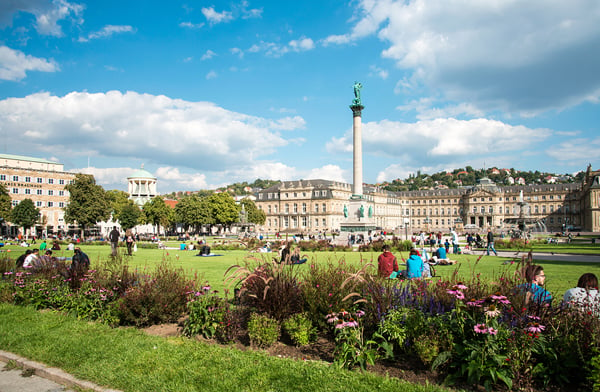Retire in Stuttgart Guide
Summary: Retire in Stuttgart with confidence, armed with the knowledge from our extensive guide. It covers critical considerations for retirees, from the cost of living and climate to housing, healthcare, and residency choices in Stuttgart. We also delve into the social and cultural scene, volunteering options, public transportation facilities, and the city's walkability, helping you make an informed decision.

Stuttgart, is a popular destination for international retirees due to its high quality of life, excellent healthcare, and rich cultural offerings. The city is known for its picturesque landscapes, world-class museums, and vibrant food scene. However, retiring in Stuttgart also presents challenges such as learning a new language and adapting to a different cost of living.
Living Expenses in Stuttgart
Stuttgart is one of the wealthiest cities in Germany, and the cost of living reflects this. Housing, in particular, can be quite expensive, especially in the city center. However, retirees can find more affordable options in the surrounding suburbs. Groceries, dining out, and transportation costs are comparable to other major European cities. It's worth noting that the quality of goods and services in Stuttgart is generally high, which can make the cost of living feel more reasonable.
Stuttgart's Climate
Stuttgart experiences a temperate seasonal climate, with warm summers and cool winters. The city is known for its beautiful spring and fall seasons, which offer mild temperatures and colorful foliage. Winters can be cold, with occasional snowfall, but are generally milder than in other parts of Germany. Summers are warm and sunny, with temperatures often reaching the high 20s (Celsius).
Healthcare Facilities
Stuttgart boasts a number of top-notch hospitals and clinics, including the Robert Bosch Hospital and the Marienhospital Stuttgart. These facilities offer a wide range of medical services and employ English-speaking staff, making them accessible to international retirees.
Public Healthcare System
Germany's public healthcare system is renowned for its high quality of care. International retirees can access this system, but they must first obtain a residence permit and join a statutory health insurance scheme. Many retirees opt for private health insurance, which offers more flexibility and often shorter waiting times for appointments.
Residency Options
Germany offers several types of residence permits for retirees, including the standard residence permit and the EU Blue Card. The requirements for these permits vary, but generally include proof of financial stability and health insurance coverage. It's recommended to consult with an immigration lawyer or expert to understand the best option for your situation.
Outdoor Activities and Parks
Stuttgart is home to numerous parks and green spaces, including the expansive Schlossgarten and the botanical gardens at Wilhelma Zoo. The city is also surrounded by vineyards and forests, offering plenty of opportunities for hiking and wine tasting.
Local Cuisine and Restaurants
Stuttgart's food scene is diverse and vibrant, with a mix of traditional Swabian restaurants and international eateries. Some popular spots include Weinstube Kachelofen, known for its regional dishes, and Cube Restaurant, which offers stunning city views. For a more casual dining experience, Markthalle Stuttgart is a food market with a variety of stalls selling fresh produce and prepared meals.
Language Learning Opportunities
Learning German can greatly enhance your experience in Stuttgart. The city has several language schools, such as the Goethe-Institut and Inlingua Stuttgart, which offer courses for all levels.
Local Culture and Socializing
Stuttgarters are generally friendly and welcoming, although they may seem reserved at first. Joining local clubs or participating in community events can be a great way to meet people. The city also has a number of volunteer opportunities, such as at the local animal shelter or community gardens.
Housing Options
Most retirees in Stuttgart live in apartments, which are available in a range of sizes and price points. The city center offers convenient access to amenities, while the suburbs provide more space and tranquility. Some popular neighborhoods for retirees include Bad Cannstatt, known for its thermal baths, and Killesberg, which is home to a beautiful park.
Transportation in Stuttgart
Stuttgart has an excellent public transportation system, including trams, buses, and a subway. The city is also very walkable, with many amenities located within a short distance of each other. While having a car can be convenient for exploring the surrounding region, it's not necessary for daily life in Stuttgart.
About the Author
 Betsy Burlingame is the Founder and President of Expat Exchange and is one of the Founders of Digital Nomad Exchange. She launched Expat Exchange in 1997 as her Master's thesis project at NYU. Prior to Expat Exchange, Betsy worked at AT&T in International
and Mass Market Marketing. She graduated from Ohio Wesleyan University
with a BA in International Business and German.
Betsy Burlingame is the Founder and President of Expat Exchange and is one of the Founders of Digital Nomad Exchange. She launched Expat Exchange in 1997 as her Master's thesis project at NYU. Prior to Expat Exchange, Betsy worked at AT&T in International
and Mass Market Marketing. She graduated from Ohio Wesleyan University
with a BA in International Business and German.
Some of Betsy's articles include 12 Best Places to Live in Portugal, 7 Best Places to Live in Panama and 12 Things to Know Before Moving to the Dominican Republic. Betsy loves to travel and spend time with her family. Connect with Betsy on LinkedIn.
Additional Information:
- Fun Classes for Expats Living in Stuttgart
- Public Transportation in Stuttgart
- Best Markets in Stuttgart
- Retire in Stuttgart Guide
- 7 Tips for Living in Stuttgart
- Pros & Cons of Living in Stuttgart
- Driving in Stuttgart
- The Insider's Guide to Stuttgart
- Health Care in Stuttgart
- Cost of Living in Stuttgart
- Healthcare & Health Insurance in Germany
- Best Places to Live in Germany
- Real Estate in Germany
- Pros & Cons of Living in Germany
- How to Enroll Your Children in School in Germany
- Pros and Cons of Living in Germany 2025
- 2025 Guide to Moving to Germany




